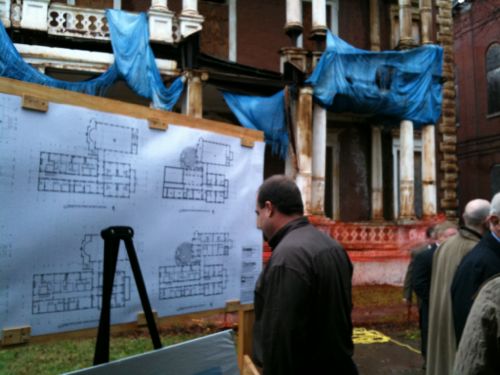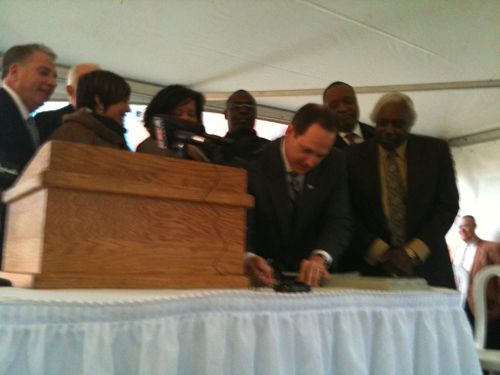Last night our Environmental Planning course, taught by Dr. Sarah Coffin, met not at our usual classroom at Saint Louis University but at the new offices of the William A. Kerr Foundation on the north Riverfront. Never heard of the Kerr Foundation? Well, you are not alone. Kerr had set up a foundation so that after he died family members would help give away his money for good causes. Two brothers, nephews of Kerr, are responsible for the foundation. One lives in California and helps distribute the money there while the other, Dr. John Sweet, lives here in St. Louis and naturally he supports causes here.
I don’t have the exact mission of the foundation but local community support and education are key components. Dr. Sweet brings a strong environmental ethic to this job — a position that brought him out of retirement. Sweet is an avid bicyclist which is how we first met, I am fortunate to be able to call him a personal friend. Sweet, through this foundation, has given money to many groups throughout the region. Now keep in mind that they don’t have the tens of millions (or even hundreds of millions) that many foundations do. Still, to some organizations doing good work, even a few thousand dollars here and there can have a huge impact.
So a few years ago Sweet decided the foundation would buy an old building on the north riverfront area, near the entrance to the bike trail. I toured the building with Sweet prior to the start of any construction and I can tell you it was pretty well deteriorated. A former 19th century bath house turned food processing facility, it had had a rough life. Today the building has undergone a $2 million dollar renovation and has been approved as the first LEED-Platinum building in the City of St. Louis.

OK, from this view it doesn’t look like much. The more interesting section is up the hill to the left, which I failed to get a good picture of! As part of the LEED process you try to minimize waste & improve efficiency so I would image that is why we still see former windows blocked up. While the foundation does not need this much space for their office, they are allowing non-profit groups to use the facility for educational purposes, including meetings.
Inside it looks pretty conventional. But items such as a dimmable florescent lighting, non-VOC paint, recycled newspaper insulation, carpet made from recycled materials, kitchen cabinets from Habitat for Humanity’s ReStore and so on are certainly non-conventional. Getting natural light into the building to reduce lighting loads, which increase air conditioning loads, was important.

A glass floor in the main area helps get natural light to a lower level, shown here looking back up.

Six reasonably conventional solar tubes on the roof help take natural light down to another lower level that was formerly completely dark without artificial lighting. Here a framework is used to protect the tops of the tubes — glass tops help these serve as outdoor tables for rooftop events. The decking is the well-known TREX material which is easily available.

Except for the deck areas, the roof is a green roof — covered in drought tolerant materials. These were recently set in place so they’ve yet to fill in but they are expected to expand and disguise their containers. To the left is an exterior elevator for full access to the roof. Not visible are solar panels facing the south, mounted on a pitched section of roof. The north riverfront trail is just beyond the flood wall seen in the background. That body of water, for those of you that don’t see it often enough, would be the Mississippi River. Â

Set on a deep base in the tiny sliver of ground to the north of the building is the first wind turbine in the City of St. Louis. On the tour we checked out the controllers that help invert the power from this and the solar panels so that it can be sold back and added to the grid. The wall of devices, meters and switches looked like something out of Frankenstein’s laboratory. Sweet says he still buys electricity but feels that it is reduced through the use of solar and wind energy. Obviously a wind turbine is not something Joe homeowner can run out and purchase. Nor can developers likely recover such costs either although as such technology becomes more commonplace we will certainly see prices drop.

Above and left is the Laclede Power Building, owned by Trailnet, may soon be renovated. At first glance you might think it is derelict and abandoned and a candidate for demolition. However, Trailnet has worked hard to keep the building intact by doing major stabilization work such as exterior tuckpointing and a new roof. While it is currently rough around the edges, the Laclede Power Building will be reborn in the future and will serve many generations of St. Louisans.  Spending money on stabilization is often a far better investment than simply razing a building to create ever more vacant land. And yes, John Sweet’s foundation helped fund the stabilization and environmental remediation that took place.

Another building in the area I am hugely fascinated with is this old warehouse. A group of investors owns this building and quite a bit of land around it. I can picture a whole new neighborhood of mixed-use buildings built around those that remain. A short walk to the south, through the Laclede’s Landing casino district, and you are at the MetroLink light rail station. I would love to live in this building! Note to self, call the one investor you know and see where they are with this project.
Following the tour our class met in the main space of the foundation’s building for actual lecture and discussion. One person we learned about was Garrett Hardin who, in 1968, wrote a still controversial paper, The Tragedy of the Commons. The basic premise being that selfish individual interests can end up destroying the common good — fishermen that over fish an area can ruin the fishing not only for themselves but others as well. We didn’t get into his views on human overpopulation as well as he and his wife’s belief in choosing when to die — they committed suicide together in 2003 — both were in their 80s.Â
We also looked at the writings from the late Rachel Carson. Carson was a marine biologist and her writings on the impact of DDT on bird populations helped ban the use of the pesticide in the US. Monsanto apparently still makes DDT for use on crops in countries like Mexico. Some consider Carson’s 1962 book, Silent Spring, a significant part of the birth of the environmental movement that led to the first earth day in 1970 as well as major environmental laws enacted during the Nixon administration.Â
We reviewed/discussed many more topics in class, too numerous to outline all here.  Post class I scootered around a bit and got a few more photos.Â

The Kerr foundation is in the foreground at right. This is technically still an alley although it is not really paved. The building I am madly in love with stands proud in the background.Â

The sunset, like the weather, was quite nice yesterday. This electric substation brings home the point about what it takes to power our lives, including the Mac I type this on now. I want to thank Dr. John Sweet for creating a wonderful demonstration project to help educate and prompt us to think about our decisions about building materials and energy use.

















